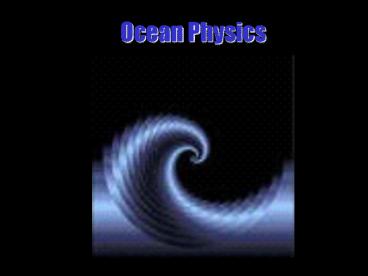Ocean Physics - PowerPoint PPT Presentation
1 / 35
Title:
Ocean Physics
Description:
Ocean Physics The Electromagnetic Radiation Spectrum Light Absorption in the Ocean Light Intensity decreases with depth 0-100 m (photic zone) 100-1000m (dysphotic ... – PowerPoint PPT presentation
Number of Views:65
Avg rating:3.0/5.0
Title: Ocean Physics
1
Ocean Physics
2
Ocean Physics
- Buoyancy
- Temperature
- Light
- Density
- Pressure
- Depth
- Salinity
- Sound
- Dissolved Gasses
3
Buoyancy
4
Archimedes Principle of Buoyancy A floating
object displaces a volume of fluid equal in mass
to the floating object
empty
loaded with fish
Displaced water
5
- Objects that are more dense than water will sink.
- Objects that are less dense than water will
float. - Objects that are the same density as water will
neither sink nor float.
float
Neutrally buoyant
sink
6
Organisms adaptation to buoyancy in water
- Blubber
- Swim bladder
- Pneumatophore
7
Organisms adaptation to buoyancy in water
- Air chambers
- Large liver heterocercal tail
- Buoyancy Compensator Device (BCD)
8
Temperature
9
Isotherms
60o
30o
0o
30o
60o
Lines of equal temperature
10
Sea Surface Temperature
July 2005
11
Properties of Light in the Ocean
12
The Electromagnetic Radiation Spectrum
Only green and blue wavelengths pass through
water a great distance.
13
Light Absorption in the Ocean
- Light Intensity
- decreases with depth
- 0-100 m (photic zone)
- 100-1000m (dysphotic zone)
- gt1000 (aphotic zone)
14
Light Penetration in the Ocean
Wavelength (nm)
400
700
600
500
0 m
Photic Zone
Photosynthesis
100m
No Photosynthesis
Dysphotic Zone
1000m
Aphotic Zone
65 of visible light is absorbed in the 1st m
15
Light Absorption in the Ocean
- Spectral Characteristics
- red wavelengths absorbed more readily by water
than blue wavelengths - blue light penetrates deepest in the oceans
16
Light effects organisms residing in the photic
and aphotic zone.
- Phytoplankton productivity
- Algae- green, brown, red
- Predator/Prey relationships
- Diurnal vertical migration
- Bioluminescence- luminescent organs on underside
mimic downwelling light
17
Refraction- as light enters the water, it bends
this is due to light traveling through different
densities
Light entering the ocean is weakened by
scattering and absorption.
18
Density
19
Density
1 ft
1 ft
1 ft
Air 0.08 lbs
fw 62.4 lbs
sw 64 lbs
1 ft
1 ft
1 ft
Piston example
Air is compressible
Water is incompressible
20
64 lbs
Water doesnt change density under pressure
64 lbs
21
Temperature Salinity Density Low
High Low High Low High
surface
0 m 100 m 1000 m
thermocline
pycnocline
halocline
Thermocline Halocline Pycnocline
22
Sound in Water
23
Sound in Water
Speed of sound- faster in ocean (higher
density) 1500 m/sec, which is 4x faster than in
air Difficult to determine direction of
sound Can hear many things such as ships
miles away, shrimp eating, helicopters overhead,
and whales communicating.
source of noise
24
Speed of Sound (m/sec)
1,475
1,500
0 1000 2000 3000 4000
high speed
sofar layer
min speed
Depth (m)
high speed
25
SOFAR Channel
Distance
0 500 1000 1500 2000
sound rays
Depth (m)
SOFAR channel
26
Sofar Layer
The depth at which the speed of sound is minimum
Thus, loud noises can be heard for thousands of
km Sound generated by Navy test in Indian Ocean
at sofar layer was heard as far away as the
Oregon coast. May affect behavior and anatomy of
marine organisms
27
Dissolved Gasses in Seawater
28
Solubility of Gases in Seawater as a Function of
Temperature (salinity _at_ 33o/oo)
Solubility (ml/l at atmospheric
pressure) Temperature N2 O2 CO2 (oC)
. 0 14.47 8.14 8,700
10 11.59 6.42 8,030 20
9.65 5.26 7,350 30 8.26 4.41 6,660
29
Relationship between water depth, pressure, and
volume
Air weighs 14 lbs/in2 (psi)
Absolute pressure is the combined pressure of
water and air
Depth 0 ft 33 ft 66 ft 99 ft
Absolute Pressure 1 atm 14.7 psi 2 atm
29.4 psi 3 atm 44.1 psi 4 atm 58.8 psi
Volume x1 x 1/2 x 1/3 x 1/4
30
Boyles Law
For any gas at a constant temperature, the volume
will vary inversely with absolute pressure while
the density will vary with absolute pressure.
I.e., volume ? with ? pressure ? pressure ?
density
31
Daltons Law of Partial Pressure
The total pressure of a gas exerted by a mixture
of gas is the sum of the gases exerted
independently.
Air partial pressure (mm Hg) N2 78.6 597 O2 21
.0 159 CO2 0.04 0.3 H2O 0.46 3.7 Total 100 760
Partial pressure is directly related to its in
the total gas mixture. E.g., at 1 atm PO2 159
mm Hg
32
Henrys Law
When a mixture of gas is in contact w/a liquid,
each gas will dissolve in the liquid in
proportion to its partial pressure.
Gasses can go in and out of solution e.g., open
soda, get CO2 bubbles (CO2 is under pressure)
33
Dissolved gasses in seawater Seawater Air N2 4
8 78 O2 36 21 CO2 15 0.04 Gasses
dissolve most readily in cold water
34
Decompression sickness
It is caused when N2 enters the blood circulation
and the tissues. When extra N2 leaves the
tissues, large bubbles form. N2 bubbles can
travel throughout the system and into the lungs
and blood routes. Treatment hyperbaric chamber
35
Inquiry
- What is isostacy?
- Why do objects in water seen from the surface
appear to bend? - Which gas is responsible for decompression
sickness? - If a balloon is brought to 6 atm, what would its
volume be? - Which wavelength of light penetrates the ocean
the deepest?































